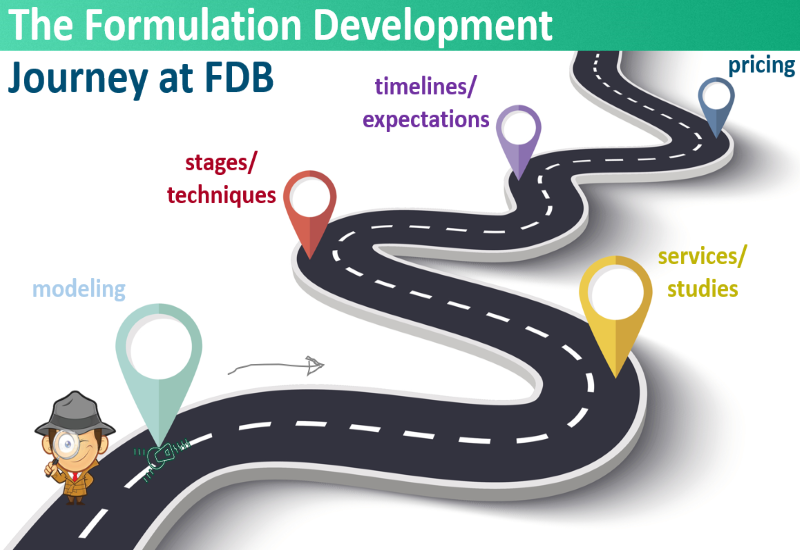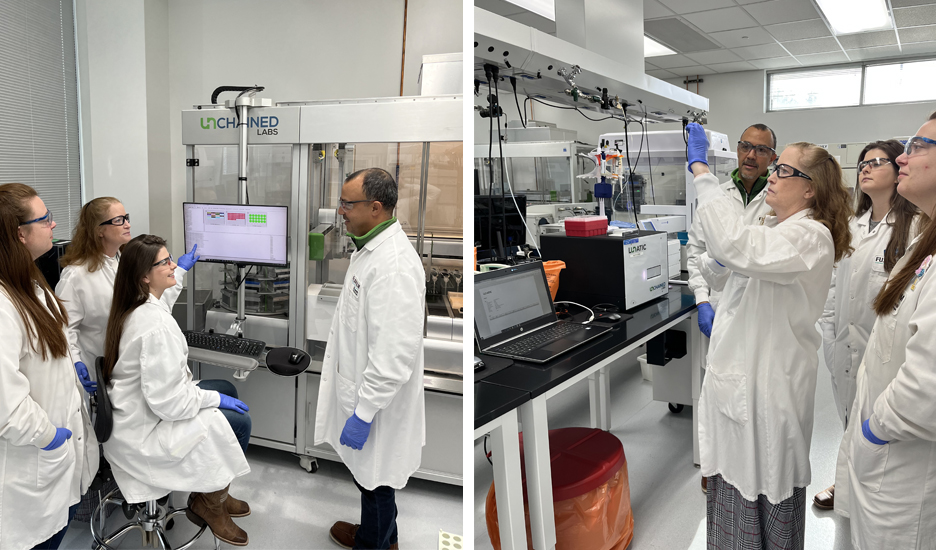The Formulation Development Journey at FUJIFILM Diosynth Biotechnologies
By Katherine Bowers and Francisco Gonzalez
One of the most critical, and often overlooked aspects of a successful biological pharmaceutical is the formulation used to create a stable drug product for pre-clinical, clinical, and commercial applications. A molecule with great therapeutic potential is only as good as its shelf life and the amenability with the route of delivery.
Here at FUJIFILM Diosynth Biotechnologies (FDB), we start thinking about the formulation of your biological drug even before the lab-work begins!
Formulation development is a journey that FDB travels with you, as a team partner, with the destination being a successful launch of your molecule into patient populations that are waiting for better treatments and cures for life-changing illnesses.

It is a common misconception that the road to a successful biologic formulation is a well-worn and well-known path that is easy to travel. We must keep in mind that every molecule has its own “personality,” and therefore, can respond very differently to stressors, conditions, and formulation components, even if the only change is one amino acid. The road that seems to be well-traveled will inevitably have some surprising twists and turns that are better navigated with strong, scientific, data-driven decisions along the journey. Successful formulation journeys start with a roadmap where scientific studies and decision points are used to create a route for understanding a molecule’s personality and its viability to help it along the way to the ultimate user – the patients.
In the arena of formulation development, the roadmap is composed of molecular information that is collected using innovative, information-rich and scientifically-sound computational, biophysical and biochemical analysis. With our proven techniques and methods, we collect as much information as possible about your molecule, so we can prepare a detailed roadmap for you. Here is a quick look at some of the critical statements and questions we ask to examine your molecule and understand its personality (strengths and liabilities):
- Using structural modeling software, we start with the sequence of your molecule to answer: where are the “hot spots” for potential aggregation or chemical degradation?
- Using biophysical analysis, we go deeper to look at:
- How well is your molecule folded as indicated by spectroscopy (Circular Dichroism, Fluorescence, FTIR) and stability analysis (Differential Scanning Calorimetry, Isothermal Chemical Denaturation)?
- How likely is your molecule to self-associate by light scattering (Dynamic Light Scattering, Multi-angle Light Scattering in-line with SEC or Composition Gradient-MALS), and by ΔG trending with Isothermal Chemical Denaturation?
- Will particulates become an issue during the stress of purification and formulation (Micro-Flow Imaging MFI™, HIAC™, Horizon™ and AURA™)?
- Using biochemical techniques, we look at profiles and rate of degradation:
- What potential chemical degradation mechanisms might be at play (Mass Spectrometry, SE-HPLC, Reduced and non-reduced CE, or icIEF)?
View video about our Formulation Development Approach
These are questions that we ask and information that we gather to start to map out the path to a successful formulation development journey for your molecule. At FDB, we are flexible and adjust our approach to your needs, so we can evaluate your molecule for manufacturability, efficacy, quality control, cost effectiveness, but most importantly, for producing the safest product for patients.
With molecular-based information in hand, our next step is to take your molecule through an “obstacle course” of stress conditions to find out what needs to be mitigated by formulation conditions. Temperature, freeze/thaw, agitation, oxidation, and pH stress are some of the obstacles that the molecule will face. How the molecule responds to these stressors, although artificially induced, sets the stage for the selection of the formulation components that will be investigated for their stability enhancing effects, as well as the nature of the formulation (frozen, refrigerated, room temperature or lyophilized).
Now that our road map is better defined, the real formulation development journey begins.

Automated, high throughput buffer exchange system is setup during initial “wide net” matrix of buffers, pH and excipients screening, that includes onboard analytics. Visual inspection and concentration measurements are always conducted across the entire workflow.
Briefly, we start with a “wide net” matrix of buffers, pH and excipients that have been selected based upon the approved protein therapeutic inactive ingredient database. Given over 4 years of proven success with this buffer matrix and the targeted analyses used for protein personality assessment, the top buffer type(s), pH range, and stabilizing excipients can be identified efficiently during the first weeks of experimentation. The time for narrowing in on the final formulation is at hand. The next stage involves a “narrow net” matrix of buffers that are tailored for your molecule with the goal of maximizing stability. After several weeks of accelerated and real-time stability, data for up to 25 assay parameters have been collected using a combination of biophysical and biochemical testing. At the end of this “narrow net” screen, the strongest stability-indicating data has been assessed using a desirability matrix approach to arrive at the top 2-3 formulations for your protein. Now it is time to really challenge the protein and the formulations by using extended light scattering to study the predictive solubility of your molecule in the chosen formulation. At the end of this deep dive into protein self-interaction, a top advisable protein concentration is recommended, and the final two formulations are selected. To close out the formulation development journey for a liquid formulation, we execute a confirmatory study using both accelerated and real-time stability, biophysical and biochemical analysis, and degradation rate investigations to select the final formulation of the protein in time for the first large scale run that connects the upstream and downstream processes. We collect several months of real-time stability data to overlap with data coming from larger scale runs. In as short as four months, your molecule will be ready to head out of our doors and into the pre-clinical toxicology studies that will enable future patient treatments.
What happens if the molecule and its delivery require a lyophilized formulation? Our freeze-drying knowledge and our in-house lab scale lyophilizer with SMART™ technology allow us to pursue a lyophilized formulation either in parallel or in a staggered fashion to the liquid formulation.
At FDB, we believe our integrated approach within all aspects of analytical and process development gives our formulation development programs a great deal of added advantages. The same information that drives our selection of a formulation for your molecule can be used to identify and mitigate potential stability issues during upstream and downstream operations. In fact, our formulation development functional area gets involved in a program as early as the “vial crack” for cell culture or fermentation.
All of us in our integrated process development team at FDB take the journey together with you toward the goal of bringing life-saving therapeutics to patients around the world as your – Partners for life.
To learn more about Formulation Development and how we can help to progress your molecule from lab to clinic to market, follow us in our next blog or contact us today.
AUTHORS:
Katherine Bowers, PhD, is a Senior Principal Scientist in our Analytical Development Department and leader of the Formulation Development Group.
RTP, North Carolina.
Francisco Gonzalez, PhD, is an Associate Director in the Global Strategic Technical Marketing Team and a former member of the Formulation Development Group.
RTP, North Carolina.